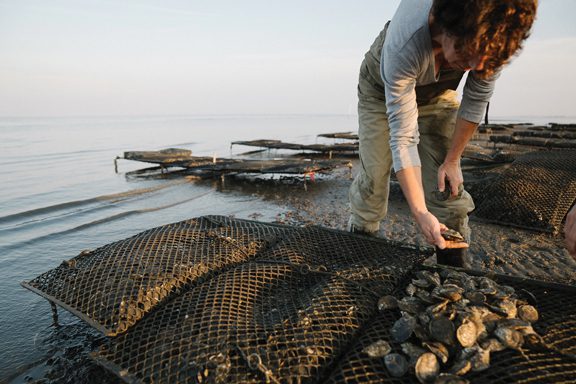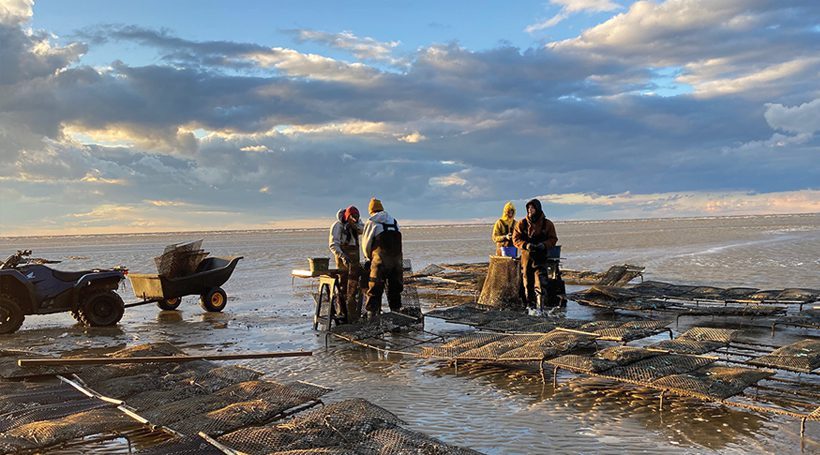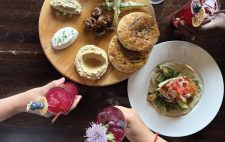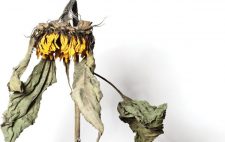As the tide goes out in the southern Delaware Bay, the farm comes into view: cages, suspended on racks, that hold thousands of oysters. This is Sweet Amalia Oyster Farm, where some of the country’s best oysters are being produced with the help of science.
“I always wanted to be a marine biologist,” says Lisa Calvo, the farm’s co-owner. “I just kind of lucked into a job at Rutgers University, at their shellfish research laboratory, and that was really an introduction to all things oysters.”

Calvo spent years studying the effect of disease on wild oysters, becoming an expert in their growth and development. She helped develop breeds of shellfish that can fend off pathogens.
“They’re robust, and they’ll survive to market size,” she says. Those oysters have thrived in hatcheries and enabled farming operations to expand in the watershed. In 2000, Calvo and her now-ex-husband started their own “little side hustle farm” on the Chesapeake Bay, where they were living at the time. They named it Sweet Amalia, after their toddler daughter.
Around 2013, the family returned to New Jersey and “Sweet Amalia Oyster Farm was kind of reborn here,” Calvo says. “I was still working at Rutgers University on various research projects with a focus on aquaculture.”
 Running her own farm, Calvo says, was the best way to figure out how to help other farmers. At Sweet Amalia, things begin with seed oysters – tiny shellfish from a hatchery – which are suspended inside large rectangular mesh cages to protect them from predators and the elements as they grow.
Running her own farm, Calvo says, was the best way to figure out how to help other farmers. At Sweet Amalia, things begin with seed oysters – tiny shellfish from a hatchery – which are suspended inside large rectangular mesh cages to protect them from predators and the elements as they grow.
“There are different ways to grow them,” Calvo explains. “They all involve some type of container – sometimes floating cages. In the case of my farm, we operate in a very shallow area of the lower bay. At low tides, you can see them and work with them. And then at high tide, there’s like 5 feet of water over them. There’s about a 6-mile stretch in the southern Delaware Bay where this type of farming method is appropriate.”
Things started small, Calvo says. “We’d sell directly to restaurants in Philadelphia. At the beginning, we had 2 restaurants we worked with, and twice a week we’d deliver fresh oysters. As the production increased, the customer base grew. We were putting the freshest oysters possible out there – very high-quality oysters – and chefs from other restaurants would have the oysters, and then they would start calling wanting these oysters.”
In 2016, Calvo and her husband split, and he returned to his native South America. She kept the farm going – and growing – and last spring she left her position at Rutgers to be a full-time oyster farmer.
“Now,” she says, “I definitely have way more demand than my production.”
“Every oyster, depending on where it’s grown, is going to pull its flavor from that place,” Calvo says. “You can eat an oyster from Maine and an oyster from Barnegat Bay in New Jersey, and an oyster from the southern Delaware Bay in New Jersey, and they’re all going to taste a little bit different.” The Sweet Amalia oysters have a reputation for tasting smooth and buttery – not as salty as oysters found in other parts of the bay. The farm has become one of a number that are springing up along the coast, restoring one of South Jersey’s true heritage industries and feeding what Calvo calls an “oyster Renaissance.”

“It’s very hard, dirty work. But you’re outside and seeing nature every day,” Calvo says. “The sky is dramatic – the sunrise is dramatic, the sunset is dramatic. And there’s just this opportunity to share a natural connection with our environment that most people don’t have the pleasure of enjoying on a day-to-day basis.”
It’s an experience she’s always happy to share with visitors who want to come out to the farm and see the operation for themselves. “There’s been a lot of interest in agri-tourism around oyster farming,” she says. “I’m always responding to requests for tours, and I think it’s great because it reconnects us to where our food’s coming from.”
And now, Calvo’s oysters aren’t just going to upscale Philadelphia restaurants. Last year, Calvo opened Sweet Amalia Market & Kitchen in Newfield with chef Melissa McGrath and investor Ed Pappas.

“It was really a pandemic baby,” Calvo says. “When the pandemic hit, and all the restaurants basically shuttered their doors, our sales fell away. At that time, I didn’t really have a retail base. I’d have a few people I knew who would call me when they wanted oysters, but it definitely wasn’t part of my business model.”
But just before the pandemic hit, the Sweet Amalia team had purchased a former farm stand as a place to pack and refrigerate oysters on their way to Philadelphia. Once the restaurants closed, they began to see its potential as a retail and restaurant location. “As the supply chain was breaking down and the supermarkets were sold out of things, there were people who were really interested in supporting local farmers,” says Calvo.
The Market & Kitchen has a menu of soups, salads and sandwiches, and of course, oysters on the half shell. “We serve Sweet Amalias, but we also serve oysters from other New Jersey farms,” Calvo says. “We always have at least 1 other oyster on the menu so people can experience these different flavor profiles.”
So far, the approach is really, really working.
“Last fall,” Calvo says, “we made Esquire Magazine’s list of the top 40 restaurants in the country.” And this year, Chef McGrath was named a semi-finalist in the 2023 James Beard Award under Best Chef – Mid-Atlantic.
“We’re working hard to continue to be successful and keep things fresh and interesting,” Calvo says. “It’s a really exciting time to be a farmer.”














